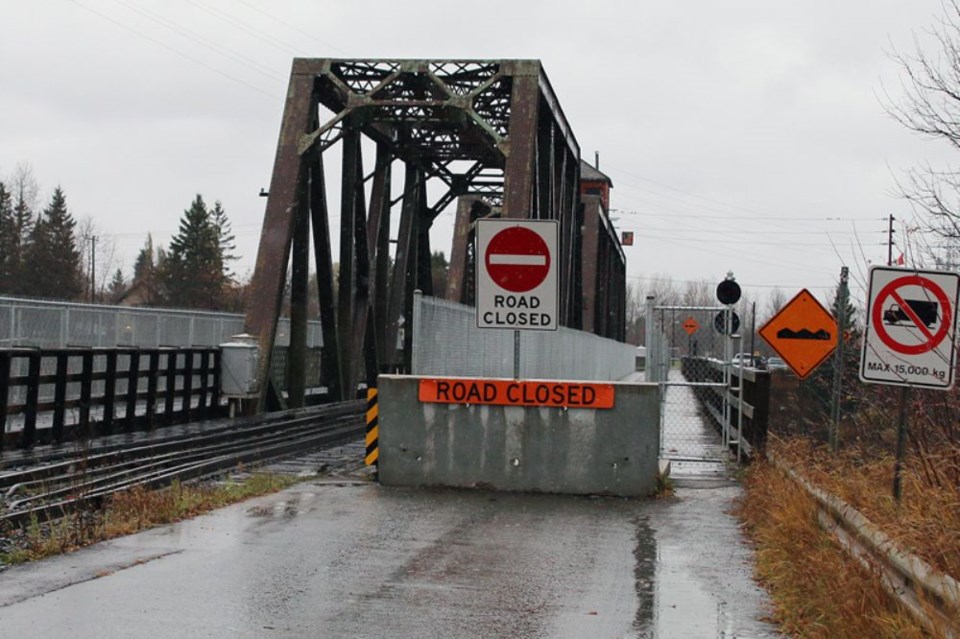THUNDER BAY – Thursday will mark the two-year anniversary of a blaze that damaged the James Street Swing Bridge, resulting in the span’s ongoing closure to vehicular traffic.
But as CN Rail, which owns the bridge, and the City of Thunder Bay have spent the past time unsuccessfully negotiating to restore the connection to Fort William First Nation across the Kaministiquia River, residents are stuck navigating through an 11-kilometre detour through Highway 61.
But even though the disruption has been ongoing for such a lengthy time period, even as trains resumed crossing the bridge only three days after the fire, the impacts run deep through the affected communities.
Fort William First Nation Chief Peter Collins said economic consequences from the closure are felt on both sides.
“There are some community members who are struggling. If you look along our route some gas stations have closed, some have dwindled down and some are financially struggling,” Collins said on Wednesday.
“It’s also impacted people from the Westfort and the city side. It’s starting to cost them more to come to work. We have close to 1,000 people that come work in our community day in and day out.”
Collins added he has heard from Thunder Bay business owners who operate coffee shops and grocery stores within close proximity to the bridge that they have noticed an impact.
In addition to commuters who have to travel the longer route to get to work, the bridge closure also affects city residents who are going out to the Fort William First Nation Arena, Chippewa Park and to the community’s gas bars.
Also, one of Fort William’s revenue generating programs has suffered significantly.
“We see it with our bingo returns which have dropped by close to $1 million,” Collins said. “That’s a big number over a couple of years.”
In addition to economic worries, there are also significant public safety concerns.
Collins is expressing alarm that the bridge closure hinders the ability of emergency responders to rush to any scene or incident.
Superior North EMS acting chief Wayne Gates said ambulance response times have increased by two minutes as a result of the closure, which isn’t enough of a delay to cause panic.
“Ideally we want to see the bridge reopened sooner rather than later,” he said. “We do want to get there quicker if we can but it hasn’t had a big impact overall on the services we’re providing.”
Gates said ambulances are dynamically deployed, meaning they are on the roads and not just sitting stationary at headquarters waiting for calls. Paramedics are also dispatched out of the James Street fire station to respond to Fort William First Nation calls.
Thunder Bay Fire Rescue chief John Hay said the relocated Westfort fire station, which is now on Neebing Avenue instead of Brown Street, has made it easier for crews to navigate around the detour, though it’s still not ideal.
“For us it’s like any other road closure or access closure and we hope it’s only temporary,” Hay said. “We’re providing the best service we can to the Fort William First Nation.”
Besides, a number of the more specialized vehicles and equipment, such as the aerial ladders, had to use Highway 61 because they did not meet the weight and roadway limitations of the bridge.
Both Gates and Hay said there are no plans at this time to locate a satellite station on the Fort William First Nation.
Even as the two-year mark hits, tt doesn’t appear a solution is imminent on the horizon.
Both CN and the city are battling the matter in court where they are asking a judge to determine whether the original agreement, which dates back more than a century, compels the rail company to repair the bridge to reopen it to vehicular traffic.
While Collins said the community is examining possible short-term solutions, any sort of decisive action such as a blockade is not on the table.
“All we can do is wait and hope,” he said.
